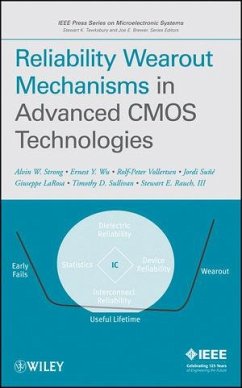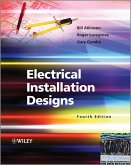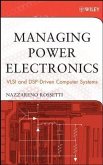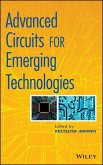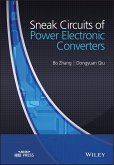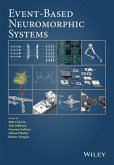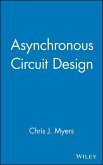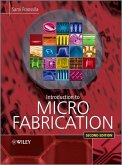Reliability Wearout Mechanisms in Advanced CMOS Technologies (eBook, PDF)


Alle Infos zum eBook verschenken

Reliability Wearout Mechanisms in Advanced CMOS Technologies (eBook, PDF)
- Format: PDF
- Merkliste
- Auf die Merkliste
- Bewerten Bewerten
- Teilen
- Produkt teilen
- Produkterinnerung
- Produkterinnerung

Hier können Sie sich einloggen

Bitte loggen Sie sich zunächst in Ihr Kundenkonto ein oder registrieren Sie sich bei bücher.de, um das eBook-Abo tolino select nutzen zu können.
This invaluable resource tells the complete story of failure mechanisms--from basic concepts to the tools necessary to conduct reliability tests and analyze the results. Both a text and a reference work for this important area of semiconductor technology, it assumes no reliability education or experience. It also offers the first reference book with all relevant physics, equations, and step-by-step procedures for CMOS technology reliability in one place. Practical appendices provide basic experimental procedures that include experiment design, performing stressing in the laboratory, data analysis, reliability projections, and interpreting projections.…mehr
- Geräte: PC
- mit Kopierschutz
- eBook Hilfe
- Größe: 8.17MB
![Electrical Installation Designs (eBook, PDF) Electrical Installation Designs (eBook, PDF)]() Bill AtkinsonElectrical Installation Designs (eBook, PDF)41,99 €
Bill AtkinsonElectrical Installation Designs (eBook, PDF)41,99 €![Managing Power Electronics (eBook, PDF) Managing Power Electronics (eBook, PDF)]() Nazzareno RossettiManaging Power Electronics (eBook, PDF)137,99 €
Nazzareno RossettiManaging Power Electronics (eBook, PDF)137,99 €![Advanced Circuits for Emerging Technologies (eBook, PDF) Advanced Circuits for Emerging Technologies (eBook, PDF)]() Krzysztof IniewskiAdvanced Circuits for Emerging Technologies (eBook, PDF)141,99 €
Krzysztof IniewskiAdvanced Circuits for Emerging Technologies (eBook, PDF)141,99 €![Sneak Circuits of Power Electronic Converters (eBook, PDF) Sneak Circuits of Power Electronic Converters (eBook, PDF)]() Bo ZhangSneak Circuits of Power Electronic Converters (eBook, PDF)128,99 €
Bo ZhangSneak Circuits of Power Electronic Converters (eBook, PDF)128,99 €![Event-Based Neuromorphic Systems (eBook, PDF) Event-Based Neuromorphic Systems (eBook, PDF)]() Event-Based Neuromorphic Systems (eBook, PDF)92,99 €
Event-Based Neuromorphic Systems (eBook, PDF)92,99 €![Asynchronous Circuit Design (eBook, PDF) Asynchronous Circuit Design (eBook, PDF)]() Chris J. MyersAsynchronous Circuit Design (eBook, PDF)152,99 €
Chris J. MyersAsynchronous Circuit Design (eBook, PDF)152,99 €![Introduction to Microfabrication (eBook, PDF) Introduction to Microfabrication (eBook, PDF)]() Sami FranssilaIntroduction to Microfabrication (eBook, PDF)67,99 €
Sami FranssilaIntroduction to Microfabrication (eBook, PDF)67,99 €-
-
-
Dieser Download kann aus rechtlichen Gründen nur mit Rechnungsadresse in A, B, BG, CY, CZ, D, DK, EW, E, FIN, F, GR, HR, H, IRL, I, LT, L, LR, M, NL, PL, P, R, S, SLO, SK ausgeliefert werden.
- Produktdetails
- Verlag: John Wiley & Sons
- Seitenzahl: 640
- Erscheinungstermin: 4. November 2009
- Englisch
- ISBN-13: 9780470455258
- Artikelnr.: 37292371
- Verlag: John Wiley & Sons
- Seitenzahl: 640
- Erscheinungstermin: 4. November 2009
- Englisch
- ISBN-13: 9780470455258
- Artikelnr.: 37292371
- Herstellerkennzeichnung Die Herstellerinformationen sind derzeit nicht verfügbar.
1 INTRODUCTION (Alvin W. Strong).
1.1 Book Philosophy.
1.2 Lifetime and Acceleration Concepts.
1.3 Mechanism Types.
1.4 Reliability Statistics.
1.5 Chi-Square and Student t Distributions.
1.6 Application.
2 DIELECTRIC CHARACTERIZATION AND RELIABILITY METHODOLOGY (Ernest Y. Wu,
Rolf-Peter Vollertsen, and Jordi Sune).
2.1 Introduction.
2.2 Fundamentals of Insulator Physics and Characterization.
2.3 Measurement of Dielectric Reliability.
2.4 Fundamentals of Dielectric Breakdown Statistics.
2.5 Summary and Future Trends.
3 DIELECTRIC BREAKDOWN OF GATE OXIDES: PHYSICS AND EXPERIMENTS (Ernest Y.
Wu, Rolf-Peter Vollertsen, and Jordi Sune).
3.1 Introduction.
3.2 Physics of Degradation and Breakdown.
3.3 Physical Models for Oxide Degradation and Breakdown.
3.4 Experimental Results of Oxide Breakdown.
3.5 Post-Breakdown Phenomena.
4 NEGATIVE BIAS TEMPERATURE INSTABILITIES IN pMOSFET DEVICES (Giuseppe
LaRosa).
4.1 Introduction.
4.2 Considerations on NBTI Stress Configurations.
4.3 Appropriate NBTI Stress Bias Dependence.
4.4 Nature of the NBTI Damage.
4.5 Impact of the NBTI Damage to Key pMOSFET Transistor Parameters.
4.6 Physical Mechanisms Contributing to the NBTI Damage.
4.7 Key Experimental Observations on the NBTI Damage.
4.8 Nit Generation by Reaction-Diffusion (R-D) Processes.
4.9 Hole Trapping Modeling.
4.10 NBTI Dependence on CMOS Processes.
4.11 NBTI Dependence on Area Scaling.
4.12 Overview of Key NBTI Features.
5 HOT CARRIERS (Stewart E. Rauch, III).
5.1 Introduction.
5.2 Hot Carriers: Physical Generation and Injection Mechanisms.
5.3 Hot Carrier Damage Mechanisms.
5.4 HC Impact to MOSFET Characteristics.
5.5 Hot Carrier Shift Models.
6 STRESS-INDUCED VOIDING (Timothy D. Sullivan).
6.1 Introduction.
6.2 Theory and Model.
6.3 Role of the Overlying Dielectric.
6.4 Summary of Voiding in Al Metallizations
6.5 Stress Voiding in Cu Interconnects.
6.6 Concluding Remarks.
7 ELECTROMIGRATION (Timothy D. Sullivan).
7.1 Introduction.
7.2 Metallization Failure.
7.3 Electromigration.
7.4 General Approach to Electromigration Reliability.
7.5 Thermal Considerations for Electromigration.
7.6 Closing Remarks.
Index.
1 INTRODUCTION (Alvin W. Strong).
1.1 Book Philosophy.
1.2 Lifetime and Acceleration Concepts.
1.3 Mechanism Types.
1.4 Reliability Statistics.
1.5 Chi-Square and Student t Distributions.
1.6 Application.
2 DIELECTRIC CHARACTERIZATION AND RELIABILITY METHODOLOGY (Ernest Y. Wu,
Rolf-Peter Vollertsen, and Jordi Sune).
2.1 Introduction.
2.2 Fundamentals of Insulator Physics and Characterization.
2.3 Measurement of Dielectric Reliability.
2.4 Fundamentals of Dielectric Breakdown Statistics.
2.5 Summary and Future Trends.
3 DIELECTRIC BREAKDOWN OF GATE OXIDES: PHYSICS AND EXPERIMENTS (Ernest Y.
Wu, Rolf-Peter Vollertsen, and Jordi Sune).
3.1 Introduction.
3.2 Physics of Degradation and Breakdown.
3.3 Physical Models for Oxide Degradation and Breakdown.
3.4 Experimental Results of Oxide Breakdown.
3.5 Post-Breakdown Phenomena.
4 NEGATIVE BIAS TEMPERATURE INSTABILITIES IN pMOSFET DEVICES (Giuseppe
LaRosa).
4.1 Introduction.
4.2 Considerations on NBTI Stress Configurations.
4.3 Appropriate NBTI Stress Bias Dependence.
4.4 Nature of the NBTI Damage.
4.5 Impact of the NBTI Damage to Key pMOSFET Transistor Parameters.
4.6 Physical Mechanisms Contributing to the NBTI Damage.
4.7 Key Experimental Observations on the NBTI Damage.
4.8 Nit Generation by Reaction-Diffusion (R-D) Processes.
4.9 Hole Trapping Modeling.
4.10 NBTI Dependence on CMOS Processes.
4.11 NBTI Dependence on Area Scaling.
4.12 Overview of Key NBTI Features.
5 HOT CARRIERS (Stewart E. Rauch, III).
5.1 Introduction.
5.2 Hot Carriers: Physical Generation and Injection Mechanisms.
5.3 Hot Carrier Damage Mechanisms.
5.4 HC Impact to MOSFET Characteristics.
5.5 Hot Carrier Shift Models.
6 STRESS-INDUCED VOIDING (Timothy D. Sullivan).
6.1 Introduction.
6.2 Theory and Model.
6.3 Role of the Overlying Dielectric.
6.4 Summary of Voiding in Al Metallizations
6.5 Stress Voiding in Cu Interconnects.
6.6 Concluding Remarks.
7 ELECTROMIGRATION (Timothy D. Sullivan).
7.1 Introduction.
7.2 Metallization Failure.
7.3 Electromigration.
7.4 General Approach to Electromigration Reliability.
7.5 Thermal Considerations for Electromigration.
7.6 Closing Remarks.
Index.
